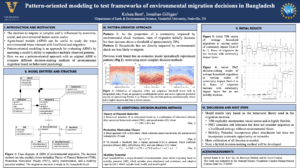2021 CSDMS meeting-052: Difference between revisions
From CSDMS
No edit summary |
No edit summary |
||
| (3 intermediate revisions by 2 users not shown) | |||
| Line 36: | Line 36: | ||
{{CSDMS meeting abstract template 2021 | {{CSDMS meeting abstract template 2021 | ||
|CSDMS meeting abstract=Environmental change interacts with human migration in complex ways and across multiple scales. This complexity makes agent-based modeling (ABM) a powerful tool to investigate environment-migration dynamics. Here, we present results from an original ABM of environmental migration in Bangladesh. The model simulates an origin community and how a stylized environmental shock to the community impacts labor opportunities and household decisions surrounding migration. Pattern-oriented modeling is a useful approach for evaluating ABM’s by assessing a model’s ability to reproduce multiple observed patterns of phenomena. We use a pattern-oriented approach to test our model’s ability to reproduce multi-level patterns of environmental migration from the literature. Previous work used machine learning methods to calibrate our ABM by identifying regions in parameter space that successfully reproduced the observed patterns. We demonstrated that a strictly income-based migration decision method was able to reproduce patterns of interest, but inconsistently. However, the pattern-oriented approach allows us to implement more complex, behaviorally driven decision-making methods of migration and evaluate their success. In this work, we will present preliminary results implementing and comparing different decision-making methods in our ABM based on existing theories including Theory of Planned Behavior, Protection Motivation Theory, and a mobility potential framework. Ultimately, we hypothesize that a hybrid framework of migration decision-making that includes community norms, social networks, and place attachment will most successfully be able to replicate known patterns of environmental migration. | |CSDMS meeting abstract=Environmental change interacts with human migration in complex ways and across multiple scales. This complexity makes agent-based modeling (ABM) a powerful tool to investigate environment-migration dynamics. Here, we present results from an original ABM of environmental migration in Bangladesh. The model simulates an origin community and how a stylized environmental shock to the community impacts labor opportunities and household decisions surrounding migration. Pattern-oriented modeling is a useful approach for evaluating ABM’s by assessing a model’s ability to reproduce multiple observed patterns of phenomena. We use a pattern-oriented approach to test our model’s ability to reproduce multi-level patterns of environmental migration from the literature. Previous work used machine learning methods to calibrate our ABM by identifying regions in parameter space that successfully reproduced the observed patterns. We demonstrated that a strictly income-based migration decision method was able to reproduce patterns of interest, but inconsistently. However, the pattern-oriented approach allows us to implement more complex, behaviorally driven decision-making methods of migration and evaluate their success. In this work, we will present preliminary results implementing and comparing different decision-making methods in our ABM based on existing theories including Theory of Planned Behavior, Protection Motivation Theory, and a mobility potential framework. Ultimately, we hypothesize that a hybrid framework of migration decision-making that includes community norms, social networks, and place attachment will most successfully be able to replicate known patterns of environmental migration. | ||
|CSDMS meeting posterPDF=Best_poster_csdms_2021.pdf | |||
|CSDMS meeting posterPNG=Best_poster_csdms_2021.png | |||
|CSDMS meeting | |||
}} | }} | ||
{{blank line template}} | {{blank line template}} | ||
Latest revision as of 20:38, 10 May 2021
Log in (or create account for non-CSDMS members)
Forgot username? Search or email:CSDMSweb@colorado.edu
Browse abstracts
Pattern-oriented modeling to test frameworks of environmental migration decisions in Bangladesh
Kelsea Best, Vanderbilt University NASHVILLE Tennessee, United States. kelsea.best@gmail.com
Jonathan Gilligan, Vanderbilt University Nashville Tennessee, United States. jonathan.gilligan@vanderbilt.edu
Environmental change interacts with human migration in complex ways and across multiple scales. This complexity makes agent-based modeling (ABM) a powerful tool to investigate environment-migration dynamics. Here, we present results from an original ABM of environmental migration in Bangladesh. The model simulates an origin community and how a stylized environmental shock to the community impacts labor opportunities and household decisions surrounding migration. Pattern-oriented modeling is a useful approach for evaluating ABM’s by assessing a model’s ability to reproduce multiple observed patterns of phenomena. We use a pattern-oriented approach to test our model’s ability to reproduce multi-level patterns of environmental migration from the literature. Previous work used machine learning methods to calibrate our ABM by identifying regions in parameter space that successfully reproduced the observed patterns. We demonstrated that a strictly income-based migration decision method was able to reproduce patterns of interest, but inconsistently. However, the pattern-oriented approach allows us to implement more complex, behaviorally driven decision-making methods of migration and evaluate their success. In this work, we will present preliminary results implementing and comparing different decision-making methods in our ABM based on existing theories including Theory of Planned Behavior, Protection Motivation Theory, and a mobility potential framework. Ultimately, we hypothesize that a hybrid framework of migration decision-making that includes community norms, social networks, and place attachment will most successfully be able to replicate known patterns of environmental migration.

